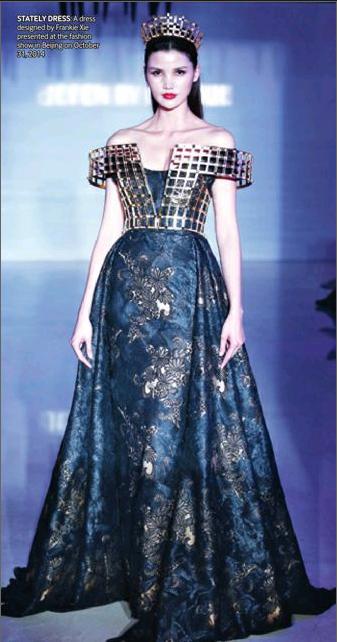Haute Couture In vogue
2015-02-05ByTangYuankai
By+Tang+Yuankai

In the fashion world, there is a saying: What is more extravagant than flying to Paris just to try on a piece of clothing?
Currently in China, only a very small number of customers own haute couture garments, partially because in a strict sense few designers can label their products haute couture.
In France, it is stipulated by law that only brands and fashion houses meeting the standards of the Paris Chamber of Commerce are eligible to use the label haute couture.
Moreover, the list of eligible brands is updated annually, and a brand must go through a complicated certification process to maintain its status.
To qualify for the haute couture label, a brand must design made-to-order items for private clients, with one or more fittings; have a workshop in Paris that employs at least 20 full-time staff members; and present a collection in January and July of each year among other requirements.
“In a sense, haute couture is a French definition,” said Zhao Qian, Director of the China office of French Federation of Fashion.
In China, the concepts of haute couture and tailor-made clothing are usually used interchangeably. The media and fashion industry generously use the term haute couture to describe the collection of many top designers. In fact, only a small number Chinese designers are the “invited members”of French Federation of Fashion, such as Ma Ke and Laurence xu.
Ma is famed for designing dresses for Peng Liyuan, wife of Chinese President xi Jinping, during her first foreign tours.
xu caught the worlds attention when he designed a yellow dragon gown that actress Fan Bingbing donned at the Cannes Film Festival in 2010, a replica of which is now in Londons victoria and Albert Museum.
Haute couture—that is, in a broad sense, luxury, tailor-made clothing—is a fledgling industry in China, as peoples living standard improves and customers needs are increasingly diversified.
In actuality, tailor-made clothing has long been a tradition in China. Tailor shops used to be small, and after the countrys industrialization, many were shut down as people turned to mass produced readymade clothes.
Nonetheless, there is a niche market for luxury tailored clothing. Celebrities are the main buyers of personally made attire. When celebrities get together, wearing exactly the same dress can be embarrassing. Even ordinary people would like to wear something special for important occasions in their life.
On international stages, Chinese celebrities not only want their outfit to reflect their unique personal style, but also their cultural heritage. That gives the rise to the need for home-grown designers.
Trendsetters
In 2006, Frankie xie, the creator and art director of the JEFEN by Frankie brand, became Chinas first designer to take his collection to the global haute couture stage.
On October 31, 2014, he released a scenery-themed collection for 2015 together with Copenhagen Fur, a world leading fur producer.
Drawing inspirations from space, nature and oil paintings, xie presented exquisitely elegant clothing made from fur.
xie studied fashion design in Japan, where he won a gold medal in a Japanese young Fashion Designer Award in 1990. He had worked as a designer for various top designer houses including prestigious Japanese brand Nicole before he started his own in 2000.
xie is a trend-setter not only in design, but also in the management of fashion hous- es. He partnered with Beijing Shuangfeng Network Technology Co. Ltd. to launch an online-order platform for tailor-made clothing. Through the platform, customers can specify their needs online, then visit brickand-mortar stores to complete the process.
JEFEN is also the first apparel company listed in the National Equities Exchange and Quotations (NEEQ), Chinas version of NASDAQ.
“Getting listed in NEEQ means that we need to withhold the rigorous test of the market,” Xie said. He said that JEFEN will raise funds from the capital market to strengthen research and development, and use Internet technology to innovate the marketing model of a fashion brand.
To xie, fast consumption of massmade ready-to-wear clothing not only compromises individuality, but also wastes natural resources and pollutes the environment.
xie aspires to bring haute couture closer to the general public. Haute couture garments are usually expensive, yet xie believes that it is no longer exclusively for celebrities.
By marrying brick-and-mortar shops with online ordering, they can produce whatever consumers need, and there will be no wasted inventory, he said. Through the Internet, the fashion company and designers can make profits, whereas consumers can enjoy more benefits, which is a win-win for everyone, he added.
“The Internet era is one in which ordinary people can live a better life,” he said.
In 2014, due to economic slowdown, Chinas apparel industry was sluggish, with continuous slips in sales and net profit. Moreover, the industry has long been under the twin pressures of large inventories and the high rental costs of storing them. In the current business environment, highend brands can hardly thrive only through traditional marketing methods such as promotion, advertising and order-placing meetings.
Some industry analysts think that tailormade high-end clothing is a promising choice for name brands, since it can meet individual needs and avoid inventory costs while allowing new markets to be explored.
Like xie, another well-known fashion designer named Zeng Fengfei is also trying to bring haute couture into the lives of common people.
Zeng is one of the designers that made clothes for the APEC Economic LeadersMeeting held in Beijing in November 2014. A highlight of the annual meeting is the group photo of the APEC leaders donning costumes reflecting the fashion and tradition of the host nation.
The preparatory committee of Beijings APEC meeting invited 348 outstanding designers in the country to offer their designs. Zeng stood out and was selected for the project.
Brocades and satin were chosen. These fabrics are luxurious but not showy, suitable to make formal dress for leaders. “This style of traditional Chinese dress can be tailored for different occasions,” Zeng said.
Nonetheless, since the fabrics are expensive and the technology is complicated, the costumes for APEC leaders are pricy. Zeng said that he will choose materials and designs to make the dresses affordable.
He believes that adequate market positioning is the life of Chinas tailor-made clothing industry. Unlike the haute couture abroad, tailor-made clothing in China are of high quality yet the prices are not “beyond reach,” he said.
Zeng grew up in a fishing village in Xiapu County, southeast Chinas Fujian Province. When he was a child, he dropped out of school because of family hardship, and then fished for more than 10 years.
He liked painting, and often drew pictures in the sand with a stick. His elder sister was a seamstress, so he learned to sketch clothing designs. Later, he left the fishing village to work as a librarian in the library of xiamen University, where he spent most of his spare time reading.
In 1993, he began to study in the Academy of Art and Design of Tsinghua University. Upon finishing his studies, he set up his own work studio, and has since worked as a fashion designer for more than two decades.
In 2008, he created his own brand FENGFEI·Z and in 2014, he opened a haute couture center. He is reputed as the leading design for Chinese style mens clothing.
While Zeng specializes in male clothing, Guo Pei mainly designs for women. Her clients include famed hostesses, actresses and athletes in China.
She has designed costumes for hostesses and artists performing at the annual Chinese New year Gala of China Central Television, a highlight of the festival viewed by millions of Chinese at home and abroad.
Guo has also designed dresses worn at various ceremonies for the 2008 Beijing Olympic Games, including the outfit actress Zhang Ziyi wore in Greece to initiate the torch relay and the elaborate dress worn by singer Song Zuying at the closing ceremony.
Some of her clients are international, such as singer Lady Gaga and supermodel Carmen DellOrefice.
Guo designed her first clothes when she was a child. In 1982, she went to university to study fashion design.
Guo has worked as the lead designer for several clothing companies. While she worked for Beijing Tianma Clothing Co., the company registered annual sales exceeding 3.9 billion yuan ($629 million), and rose to become one of Chinas top 10 clothing brands.
In the 1980s, while most people in China earned no more than 100 yuan ($16) per month, Guo made more than 10,000 yuan($1,600). In 1997, she founded her own company. For 10 years, she worked diligently behind the scenes, expanding her business. In addition to high-end dresses, she also designed swimsuits, pajamas, underwear, headwear and shoes.
To produce exquisitely made clothing with the best materials, Guo sometimes disregarded the costs entirely.
At the closing ceremony of the 2008 Olympics in Beijing, singer Song dazzled the audience with her beautiful voice and a splendid long robe studded with more than 200,000 Swarovski crystals.
Guo said that she hired a dozen people who worked on day and night shifts to finish the dress within a two-week deadline. It can take up to two years to finish a piece of haute couture clothing, so its value cannot be measured by money, Guo said.
“In the beginning, I worked hard to make a garment look pretty by using the best fabric and design while neglecting its implication,” Guo said.
She said that haute couture is an art that expresses our understanding of life. “Every piece is meticulously made with our hands and heart. The time in our life has gone into every piece of clothing, so that it has acquired a life of its own,” she mused.
To make exceptional haute couture, one should create outer beauty from within, she believes.
She said that as a Chinese fashion designer, she is proud to present her country, culture and people to the world.
